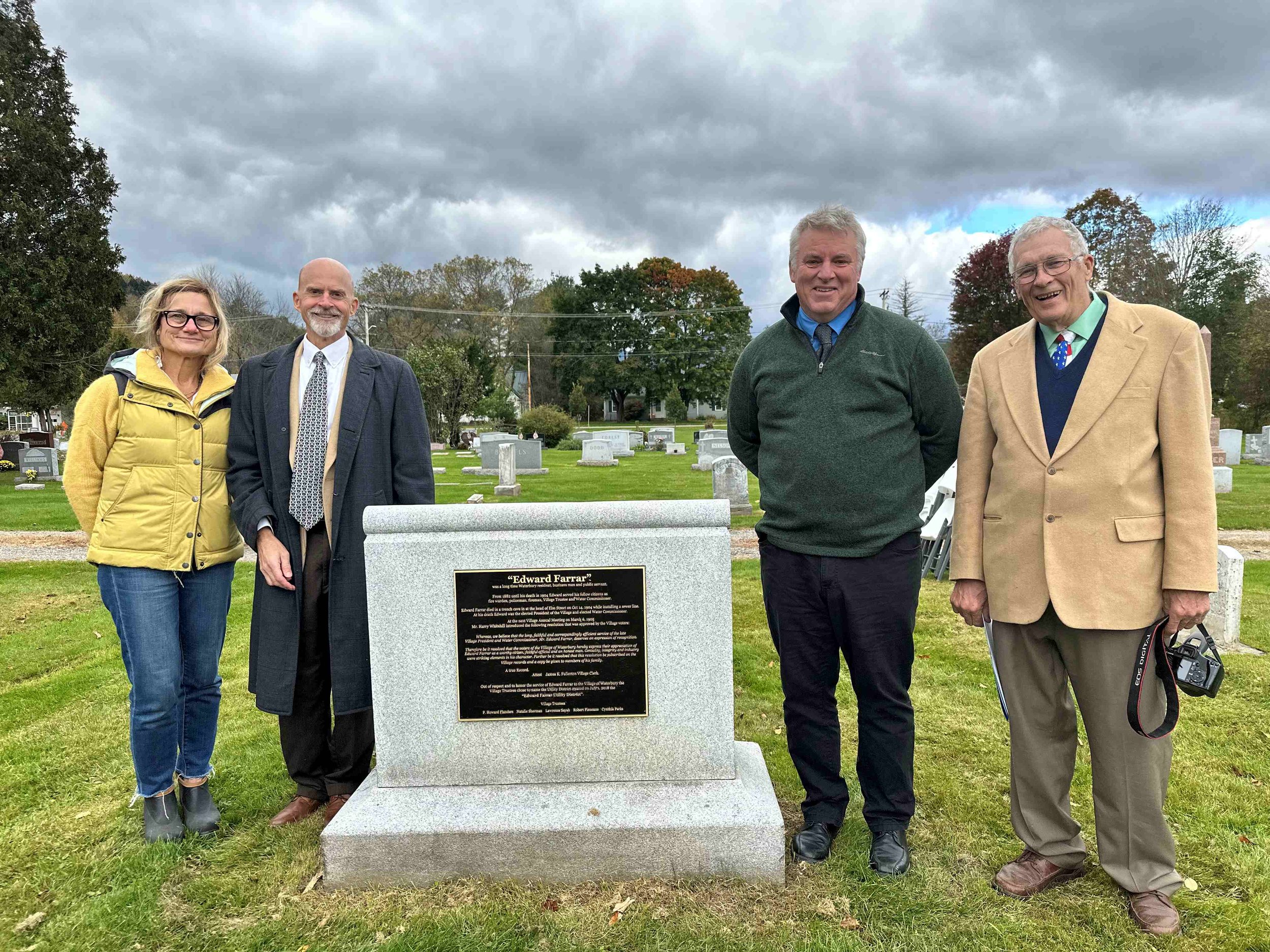Utility district honors namesake with graveside ceremony, plaque
October 21, 2023 | By Cheryl Casey | Correspondent EFUD Commissioner P. Howard “Skip” Flanders speaks beside Edward Farrar’s Hope Cemetery gravestone ahead of the plaque unveiling. Photo by Cheryl Casey
A special ceremony took place at Hope Cemetery last weekend that traced its origin back more than a century.
The commissioners of the Edward Farrar Utility District and representatives of the Waterbury Historical Society gathered in the graveyard to honor the utility district’s namesake.
As part of the ceremony, commissioners unveiled a special plaque affixed to the back of Farrar’s gravestone, detailing his extensive public service to the Village during the late 19th century.
Commission Chair P. Howard “Skip” Flanders led the program and opened with a summary of Farrar’s life and service. Born in Moretown in 1844, Farrar moved to Waterbury with his wife Eva (Hasseltine) and son John in 1880. At the first Village meeting in 1882 under the new charter, Farrar was elected as a Fire Warden.
“Edward was a lifelong public-minded citizen,” Flanders said, “and from that time forward [he] was often elected to multiple positions serving his community.”
Public Works Director Bill Woodruff shares local lore of Farrar's ill-fated service. Photo by Cheryl Casey
One of those positions was Water Commissioner, to which he was elected by acclamation at the 1903 Village meeting. A year and a half later, on Oct. 13, 1904, Farrar was supervising a sewer project at the head of Elm Street when the trench he was standing in collapsed. Farrar was almost immediately trapped, and despite nearby workers pulling him out within a matter of minutes, “he was beyond medical aid, his lungs and chest being crushed in. He gasped twice after being taken out, and died,” reported the Waterbury Record newspaper at the time.
Public Works director Bill Woodruff followed Flanders’ remarks with a short history of the water and sewer misadventures at the ill-fated intersection of Elm and South Main streets. He recalled how former wastewater operator, Pete Krolczyk, “who never had a bad word to say about anybody,” despised the intersection as “trouble from day one” with its numerous water and sewer issues.
Woodruff also told of how, while digging at the intersection for the Main Street project, the crew came across an empty basin, about large enough for a grown man to fit inside and very near to where Farrar had died.
“Not to say it’s a cursed spot, but Edward must feel that right now. [His] spirit is telling us to be careful,” Woodruff said.
Left to right: EFUD Commissioner Natalie Sherman, Rev. Peter Plagge, Public Works Director Bill Woodruff and EFUD Chair Skip Flanders. Photo by Cheryl Casey
Along with his many public service roles, including Village President at the time of his death, Farrar was also a developer, and the neighborhood of Butler, Intervale, Prospect, and Wallace streets are known as Farrar’s Addition. The 30 acres, formerly part of Gov. Ezra Butler’s farm, were subdivided into 47 lots and the neighborhood was formally incorporated into the Village in 1902.
At the Village Meeting in 1905, Waterbury Record publisher Harry Whitehill introduced a resolution which was approved by voters and is now engraved on Farrar’s plaque:
Whereas, we believe that the long, faithful and correspondingly efficient service of the late Village President and Water Commissioner, Mr. Edward Farrar, deserves an expression of recognition.
Therefore be it resolved that the voters of the Village of Waterbury hereby express their appreciation of Edward Farrar as a worthy citizen, faithful official and an honest man. Geniality, integrity and industry were striking elements in his character.
Further be it resolved that this resolution be subscribed on the Village records and a copy be given to members of his family.
Rev. Peter Plagge of the Waterbury Congregational Church concluded the ceremony with a benediction, saying of Farrar: “You cannot claim that his good will, which resulted in the betterment of the lives of his neighbor, no matter who they were, or where they lived, could be anything but good.”
Flanders said he came across Farrar’s story in 1995 while researching the Village water system. When the Village municipality was dissolved and the utility district established in 2018, the commissioners, including Flanders, chose to name the district after Farrar.
But the name alone could not tell Farrar’s story, Flanders explained. So the commissioners decided that having a plaque on Farrar’s grave marker would be appropriate. “[We] wanted to do something to recognize Edward’s service and sacrifice so that it would not be lost to history,” he said.
The ceremony on Oct. 14 took place 119 years and one day after Farrar met his tragic end.
The commemorative plaque on Farrar’s gravestone in Hope Cemetery. Photo by Cheryl Casey
Cheryl Casey is president of the Waterbury Historical Society and a professor of communication at Champlain College.



